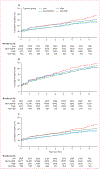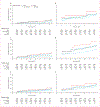Persistence of multiple illnesses in World Trade Center rescue and recovery workers: a cohort study
- PMID: 21890053
- PMCID: PMC9453925
- DOI: 10.1016/S0140-6736(11)61180-X
Persistence of multiple illnesses in World Trade Center rescue and recovery workers: a cohort study
Abstract
Background: More than 50,000 people participated in the rescue and recovery work that followed the Sept 11, 2001 (9/11) attacks on the World Trade Center (WTC). Multiple health problems in these workers were reported in the early years after the disaster. We report incidence and prevalence rates of physical and mental health disorders during the 9 years since the attacks, examine their associations with occupational exposures, and quantify physical and mental health comorbidities.
Methods: In this longitudinal study of a large cohort of WTC rescue and recovery workers, we gathered data from 27,449 participants in the WTC Screening, Monitoring, and Treatment Program. The study population included police officers, firefighters, construction workers, and municipal workers. We used the Kaplan-Meier procedure to estimate cumulative and annual incidence of physical disorders (asthma, sinusitis, and gastro-oesophageal reflux disease), mental health disorders (depression, post-traumatic stress disorder [PTSD], and panic disorder), and spirometric abnormalities. Incidence rates were assessed also by level of exposure (days worked at the WTC site and exposure to the dust cloud).
Findings: 9-year cumulative incidence of asthma was 27·6% (number at risk: 7027), sinusitis 42·3% (5870), and gastro-oesophageal reflux disease 39·3% (5650). In police officers, cumulative incidence of depression was 7·0% (number at risk: 3648), PTSD 9·3% (3761), and panic disorder 8·4% (3780). In other rescue and recovery workers, cumulative incidence of depression was 27·5% (number at risk: 4200), PTSD 31·9% (4342), and panic disorder 21·2% (4953). 9-year cumulative incidence for spirometric abnormalities was 41·8% (number at risk: 5769); three-quarters of these abnormalities were low forced vital capacity. Incidence of most disorders was highest in workers with greatest WTC exposure. Extensive comorbidity was reported within and between physical and mental health disorders.
Interpretation: 9 years after the 9/11 WTC attacks, rescue and recovery workers continue to have a substantial burden of physical and mental health problems. These findings emphasise the need for continued monitoring and treatment of the WTC rescue and recovery population.
Funding: Centers for Disease Control and Prevention and National Institute for Occupational Safety and Health.
Copyright © 2011 Elsevier Ltd. All rights reserved.
Conflict of interest statement
Conflicts of interest
JPW is a member of the research board of EHE International. All other authors declare that they have no conflicts of interest.
Figures





Comment in
-
9/11: the view ahead.Lancet. 2011 Sep 3;378(9794):852-4. doi: 10.1016/S0140-6736(11)61310-X. Lancet. 2011. PMID: 21890031 No abstract available.
References
-
- Savitz DA, Oxman RT, Metzger KB, et al. Epidemiologic research on man-made disasters: strategies and implications of cohort definition for World Trade Center worker and volunteer surveillance program. Mt Sinai J Med 2008; 75: 77–87. - PubMed
-
- Prezant DJ, Weiden M, Banauch GI, et al. Cough and bronchial responsiveness in firefighters at the World Trade Center site. N Engl J Med 2002; 347: 806–15. - PubMed
Publication types
MeSH terms
Substances
Grants and funding
LinkOut - more resources
Full Text Sources
Medical

